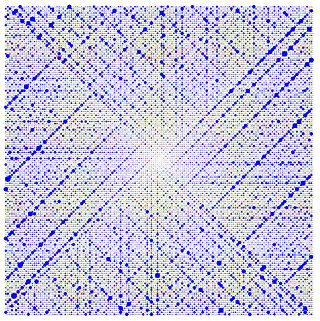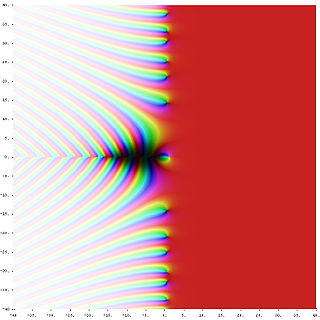
Number theory is a branch of pure mathematics devoted primarily to the study of the integers and arithmetic functions. German mathematician Carl Friedrich Gauss (1777–1855) said, "Mathematics is the queen of the sciences—and number theory is the queen of mathematics." Number theorists study prime numbers as well as the properties of mathematical objects constructed from integers, or defined as generalizations of the integers.

A prime number is a natural number greater than 1 that is not a product of two smaller natural numbers. A natural number greater than 1 that is not prime is called a composite number. For example, 5 is prime because the only ways of writing it as a product, 1 × 5 or 5 × 1, involve 5 itself. However, 4 is composite because it is a product (2 × 2) in which both numbers are smaller than 4. Primes are central in number theory because of the fundamental theorem of arithmetic: every natural number greater than 1 is either a prime itself or can be factorized as a product of primes that is unique up to their order.

A mathematical proof is a deductive argument for a mathematical statement, showing that the stated assumptions logically guarantee the conclusion. The argument may use other previously established statements, such as theorems; but every proof can, in principle, be constructed using only certain basic or original assumptions known as axioms, along with the accepted rules of inference. Proofs are examples of exhaustive deductive reasoning which establish logical certainty, to be distinguished from empirical arguments or non-exhaustive inductive reasoning which establish "reasonable expectation". Presenting many cases in which the statement holds is not enough for a proof, which must demonstrate that the statement is true in all possible cases. A proposition that has not been proved but is believed to be true is known as a conjecture, or a hypothesis if frequently used as an assumption for further mathematical work.

In mathematics, analytic number theory is a branch of number theory that uses methods from mathematical analysis to solve problems about the integers. It is often said to have begun with Peter Gustav Lejeune Dirichlet's 1837 introduction of Dirichlet L-functions to give the first proof of Dirichlet's theorem on arithmetic progressions. It is well known for its results on prime numbers and additive number theory.
Combinatorics is a branch of mathematics concerning the study of finite or countable discrete structures.

Klaus Friedrich Roth was a German-born British mathematician who won the Fields Medal for proving Roth's theorem on the Diophantine approximation of algebraic numbers. He was also a winner of the De Morgan Medal and the Sylvester Medal, and a Fellow of the Royal Society.
Sieve theory is a set of general techniques in number theory, designed to count, or more realistically to estimate the size of, sifted sets of integers. The prototypical example of a sifted set is the set of prime numbers up to some prescribed limit X. Correspondingly, the prototypical example of a sieve is the sieve of Eratosthenes, or the more general Legendre sieve. The direct attack on prime numbers using these methods soon reaches apparently insuperable obstacles, in the way of the accumulation of error terms. In one of the major strands of number theory in the twentieth century, ways were found of avoiding some of the difficulties of a frontal attack with a naive idea of what sieving should be.

Mark Kac was a Polish American mathematician. His main interest was probability theory. His question, "Can one hear the shape of a drum?" set off research into spectral theory, the idea of understanding the extent to which the spectrum allows one to read back the geometry.

Terence Chi-Shen Tao is an Australian mathematician. He is a professor of mathematics at the University of California, Los Angeles (UCLA), where he holds the James and Carol Collins chair. His research includes topics in harmonic analysis, partial differential equations, algebraic combinatorics, arithmetic combinatorics, geometric combinatorics, probability theory, compressed sensing and analytic number theory.
In number theory, natural density is one method to measure how "large" a subset of the set of natural numbers is. It relies chiefly on the probability of encountering members of the desired subset when combing through the interval [1, n] as n grows large.
The large sieve is a method in analytic number theory. It is a type of sieve where up to half of all residue classes of numbers are removed, as opposed to small sieves such as the Selberg sieve wherein only a few residue classes are removed. The method has been further heightened by the larger sieve which removes arbitrarily many residue classes.
This is a glossary of arithmetic and diophantine geometry in mathematics, areas growing out of the traditional study of Diophantine equations to encompass large parts of number theory and algebraic geometry. Much of the theory is in the form of proposed conjectures, which can be related at various levels of generality.
Additive number theory is the subfield of number theory concerning the study of subsets of integers and their behavior under addition. More abstractly, the field of additive number theory includes the study of abelian groups and commutative semigroups with an operation of addition. Additive number theory has close ties to combinatorial number theory and the geometry of numbers. Two principal objects of study are the sumset of two subsets A and B of elements from an abelian group G,
In number theory, the Erdős–Kac theorem, named after Paul Erdős and Mark Kac, and also known as the fundamental theorem of probabilistic number theory, states that if ω(n) is the number of distinct prime factors of n, then, loosely speaking, the probability distribution of
In mathematics, the Hardy–Ramanujan theorem, proved by Ramanujan and checked by Hardy states that the normal order of the number ω(n) of distinct prime factors of a number n is log(log(n)).
The Turán–Kubilius inequality is a mathematical theorem in probabilistic number theory. It is useful for proving results about the normal order of an arithmetic function. The theorem was proved in a special case in 1934 by Pál Turán and generalized in 1956 and 1964 by Jonas Kubilius.
In mathematics, the Fabry gap theorem is a result about the analytic continuation of complex power series whose non-zero terms are of orders that have a certain "gap" between them. Such a power series is "badly behaved" in the sense that it cannot be extended to be an analytic function anywhere on the boundary of its disc of convergence.
Sequences is a mathematical monograph on integer sequences. It was written by Heini Halberstam and Klaus Roth, published in 1966 by the Clarendon Press, and republished in 1983 with minor corrections by Springer-Verlag. Although planned to be part of a two-volume set, the second volume was never published.






